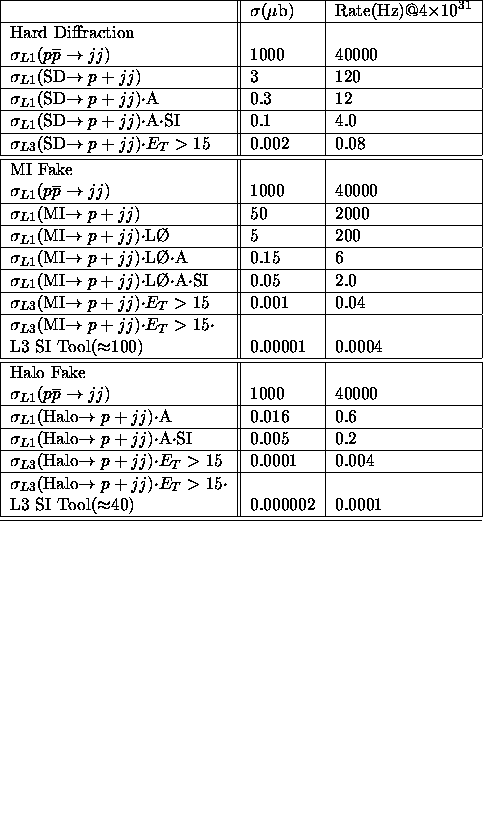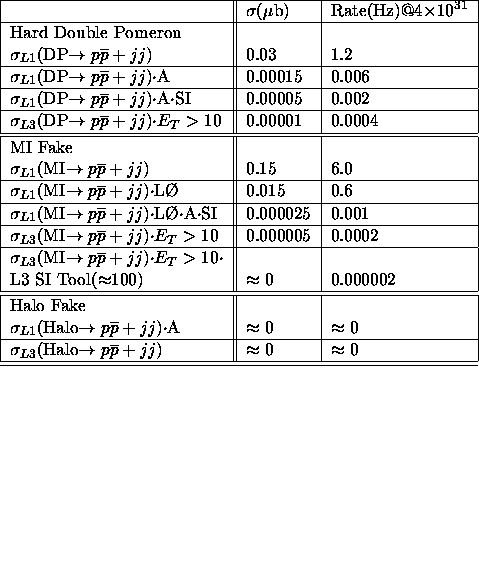
Table 8: Trigger rates (Hz), backgrounds, and number of events for hard single diffraction, hard double pomeron, and inclusive double pomeron exchange.
The trigger rates for hard diffraction, hard double pomeron exchange, and inclusive double pomeron exchange are discussed in this section. Each topic has a detailed estimate of the physics and background rates showing the effect of each trigger term. There is a table summarizing each topic. A global summary of the rates and expected number of events is given in Table 8 for a typical 4E31 luminosity.

Table 8: Trigger rates (Hz), backgrounds, and number of
events for hard single diffraction, hard double pomeron, and inclusive
double pomeron exchange.
The Level 1 rates in Hz are given by the following expression:

where ![]() is the L1 cross section, A is the spectrometer acceptance,
SI is the single interaction acceptance factor (which ranges from
1 at low luminosity to 0.1 at high luminosity),
and
is the L1 cross section, A is the spectrometer acceptance,
SI is the single interaction acceptance factor (which ranges from
1 at low luminosity to 0.1 at high luminosity),
and ![]() is the luminosity in units of
is the luminosity in units of ![]() cm
cm![]() .
.
The multiple interaction fake rate can also be evaluated using
Eq. 10, with different values of ![]() and A. In this case
and A. In this case
![]()
![]() b (0.5% of the dijet
cross section including the Level Ø cut
as discussed in the previous section).
The acceptance for quadrupole spectrometers is the same for signal and
fake background, but the dipole acceptance for fake background is much
lower due to the increased acceptance for higher
b (0.5% of the dijet
cross section including the Level Ø cut
as discussed in the previous section).
The acceptance for quadrupole spectrometers is the same for signal and
fake background, but the dipole acceptance for fake background is much
lower due to the increased acceptance for higher ![]() which has lower
background. An overall acceptance
which has lower
background. An overall acceptance ![]() % is assumed,
giving
% is assumed,
giving ![]() Hz.
The same SI factor still applies, since it refers to
the overlap of an extra minimum bias event, which would cause the rejection
of fake background that would have
otherwise passed the single interaction cut.
Hz.
The same SI factor still applies, since it refers to
the overlap of an extra minimum bias event, which would cause the rejection
of fake background that would have
otherwise passed the single interaction cut.
For halo, ![]()
![]() b as discussed earlier
(the 0.000016 already includes the acceptance for halo tracks),
so
b as discussed earlier
(the 0.000016 already includes the acceptance for halo tracks),
so ![]() Hz.
Hz.
Unlike most DØ triggers there will be little luminosity dependence of the
rates, since the rate increase
from the increased luminosity is roughly cancelled
by the ![]() acceptance factor which decreases with increasing luminosity.
acceptance factor which decreases with increasing luminosity.
From Run I the ![]() GeV jet cut gave a reduction of
about 50, giving a Level 3 physics cross section of 2 nb,
corresponding to a rate of 0.08 Hz. From the single
interaction tool, we expect a rejection of greater than 100 for fake
background and greater than 40 for halo background (in addition to
the jet rejection which applies equally to all these samples), giving
a final background rate of less than 0.0005 Hz (about 20% coming from
halo).
GeV jet cut gave a reduction of
about 50, giving a Level 3 physics cross section of 2 nb,
corresponding to a rate of 0.08 Hz. From the single
interaction tool, we expect a rejection of greater than 100 for fake
background and greater than 40 for halo background (in addition to
the jet rejection which applies equally to all these samples), giving
a final background rate of less than 0.0005 Hz (about 20% coming from
halo).
![]()
Table 9: Cross sections and trigger rates for hard single diffraction
(SD![]() ) and fake backgrounds to hard single diffraction
from multiple interactions (MI) and halo. The expression
p + j j also include the charge conjugate
) and fake backgrounds to hard single diffraction
from multiple interactions (MI) and halo. The expression
p + j j also include the charge conjugate ![]() .
.
 is about 50%. Combining this
with the 1% p acceptance yields
a total
acceptance of about 0.5%. Applying the luminosity and SI factor gives
a L1 physics rate of 0.002 Hz.
is about 50%. Combining this
with the 1% p acceptance yields
a total
acceptance of about 0.5%. Applying the luminosity and SI factor gives
a L1 physics rate of 0.002 Hz.
The background to hard double pomeron exchange is dominated by the
overlap of two inclusive diffractive interactions and a dijet event.
At 4E31, the probability of two single diffractive events
with ![]() is
is ![]() , and one-half of these cases give
a p and a
, and one-half of these cases give
a p and a ![]() . Assuming that 10% of these events survive
the Level 1 single interaction cut gives
. Assuming that 10% of these events survive
the Level 1 single interaction cut gives ![]() of the
dijet cross section or 0.015
of the
dijet cross section or 0.015 ![]() b. Applying the same acceptance
and SI factors as for the signal gives 0.001 Hz. Other
fake combinations such as a diffractive
interaction with a hard single diffractive one
are at least a factor of five smaller. Fake background involving halo
requires either two independent halo tracks superimposed with a dijet event,
or one halo track combined with a diffractive interaction and a dijet event.
In either case the small acceptance combined with
b. Applying the same acceptance
and SI factors as for the signal gives 0.001 Hz. Other
fake combinations such as a diffractive
interaction with a hard single diffractive one
are at least a factor of five smaller. Fake background involving halo
requires either two independent halo tracks superimposed with a dijet event,
or one halo track combined with a diffractive interaction and a dijet event.
In either case the small acceptance combined with
![]() renders this background negligible.
renders this background negligible.
At Level 3, the rejection is only expected to be about a factor
of 5 due to the lower ![]() threshold. Multiple interaction
background rates should
be an additional factor of 100 smaller
and can safely be ignored.
The total Level 3 physics cross section is thus about 10 pb.
threshold. Multiple interaction
background rates should
be an additional factor of 100 smaller
and can safely be ignored.
The total Level 3 physics cross section is thus about 10 pb.
![]()
Table 10: Cross sections and trigger rates for hard double pomeron
exchange (DP![]() ) and fake backgrounds from
multiple interactions (MI) and halo.
) and fake backgrounds from
multiple interactions (MI) and halo.
The multiple interaction background requires two single diffractive events
on opposite sides, which has a cross section of 50 ![]() b
(2.5% of the 2 mb cross section has a second diffractive event on the
opposite side). Applying the LØ acceptance, luminosity, and SI factors
give a small L1 rate of 0.07 Hz, which
will be completely obliterated by the rapidity gap cut on both sides
(rejection of 10,000).
Fake background involving halo is negligible as in the hard double pomeron
case.
b
(2.5% of the 2 mb cross section has a second diffractive event on the
opposite side). Applying the LØ acceptance, luminosity, and SI factors
give a small L1 rate of 0.07 Hz, which
will be completely obliterated by the rapidity gap cut on both sides
(rejection of 10,000).
Fake background involving halo is negligible as in the hard double pomeron
case.
The addition of a cut on ``X'' (some physics activity such as tracks, energy, or muons), since we will want to measure something in the event, will lower the physics L3 rate to an insignificant level, perhaps 0.001 Hz.
![]()
Table 11: Cross sections and trigger rates for inclusive double pomeron
(DP ) and fake backgrounds.
) and fake backgrounds.
The background (Bkgd) rates are dominated by multiple interactions (see Sec. 5.3) and are seen to be small compared to the signal. While there are large uncertainties in these numbers due to the limited data on these subjects, we clearly expect to obtain large samples to carry out these analyses.